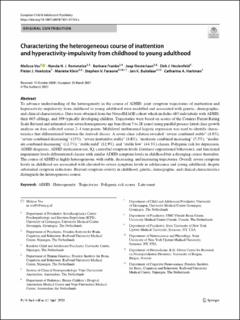Characterizing the heterogeneous course of inattention and hyperactivity‑impulsivity from childhood to young adulthood
Vos, Melissa; Rommelse, Nanda; Franke, Barbara; Oosterlaan, Jaap; Heslenfeld, Dirk J.; Hoekstra, Pieter J.; Klein, Marieke; Faraone, Stephen; Buitelaar, Jan; Hartman, Catharina A.
Journal article, Peer reviewed
Published version

Åpne
Permanent lenke
https://hdl.handle.net/11250/2827121Utgivelsesdato
2021Metadata
Vis full innførselSamlinger
- Department of Biomedicine [710]
- Registrations from Cristin [9766]
Sammendrag
To advance understanding of the heterogeneity in the course of ADHD, joint symptom trajectories of inattention and hyperactivity-impulsivity from childhood to young adulthood were modelled and associated with genetic, demographic, and clinical characteristics. Data were obtained from the NeuroIMAGE cohort which includes 485 individuals with ADHD, their 665 siblings, and 399 typically developing children. Trajectories were based on scores of the Conners Parent Rating Scale Revised and estimated over seven homogeneous age bins (from 5 to 28 years) using parallel process latent class growth analysis on data collected across 2–4 time points. Multilevel multinomial logistic regression was used to identify characteristics that differentiated between the derived classes. A seven-class solution revealed “severe combined stable” (4.8%), “severe combined decreasing” (13%), “severe inattentive stable” (4.8%), “moderate combined increasing” (7.5%), “moderate combined decreasing” (12.7%), “stable mild” (12.9%), and “stable low” (44.3%) classes. Polygenic risk for depression, ADHD diagnosis, ADHD medication use, IQ, comorbid symptom levels (foremost oppositional behaviour), and functional impairment levels differentiated classes with similar ADHD symptom levels in childhood but a diverging course thereafter. The course of ADHD is highly heterogeneous, with stable, decreasing, and increasing trajectories. Overall, severe symptom levels in childhood are associated with elevated-to-severe symptom levels in adolescence and young adulthood, despite substantial symptom reductions. Beyond symptom severity in childhood, genetic, demographic, and clinical characteristics distinguish the heterogeneous course.
